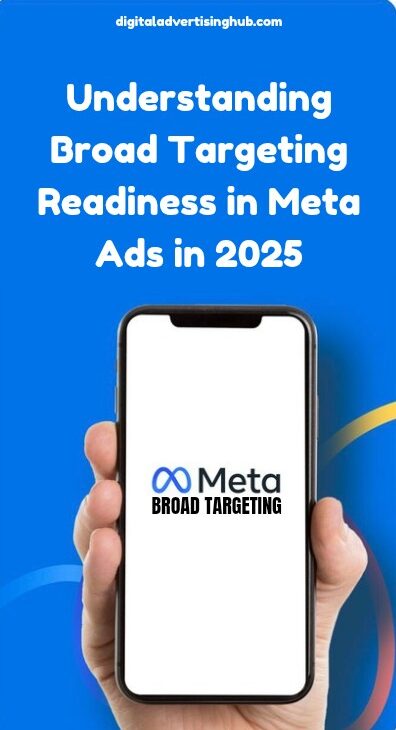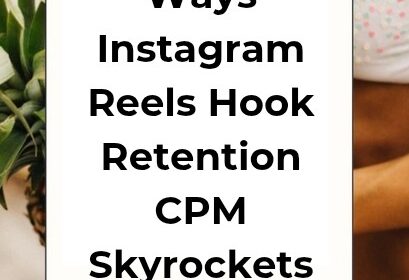If you’re trying to decide whether to launch with broad audiences or lean into narrow interest-based targeting, the meta ads broad targeting readiness test is your key checkpoint.
As Meta continues leaning into AI-driven optimization, broad targeting is becoming more powerful than ever — but only when you’re ready.
This isn’t just about letting the algorithm run wild: it’s about knowing when your account, data, and campaign setup are strong enough to make that freedom pay off.
Broad targeting historically meant using very few filters (sometimes just age, gender, or location) and relying on Meta to find the right users through its learning algorithm.
In 2025, that model has evolved into something more refined — but the core remains: if you’ve developed reliable conversion signals, you may be ready to run broad at scale.
Several expert marketers now treat broad targeting not as guesswork, but as a first-class strategy for scalable conversion campaigns.
But knowing whether you’re ready isn’t always obvious. Launching too early can lead to wasted budget, while delaying broad targeting could stunt your growth.
The meta ads broad targeting readiness test helps you evaluate your readiness based on three pillars: signal strength, creative capacity, and campaign structure.
Pillar 1: Signal Strength — Are You Feeding Meta Enough Data?

At the heart of a successful meta ads broad targeting readiness test lies strong conversion signals.
If Meta only has weak or ambiguous events to learn from, its algorithm won’t optimize well.
#1. Pixel and CAPI Setup: First, make sure your Meta Pixel and Conversions API (CAPI) are properly configured and sending high-quality events (e.g., purchases, add-to-carts).
Without them, your data will be noisy, and broad targeting may underperform. Agencies emphasize using both to give the algorithm enough unfiltered insight.
#2. Event Volume: A practical rule: if you’re generating 50–100+ conversion events per week per campaign (or per ad set), that’s a strong sign you’re ready.
Some ads strategists recommend this threshold before you unleash fully broad sets.
#3. Stable Attribution: Ensure your attribution model is robust. If Meta can’t clearly trace which ad interactions lead to conversions, it won’t optimize effectively. Also, deduplicate events via server-side tracking so you’re not miscounting.
#4. Consistent Data Cycle: Give campaigns time. In the early learning phase (7–10 days or more, depending on scale), avoid making sweeping changes. Let the algorithm accumulate enough data.
When your data pipeline is healthy, you give Meta space to learn and optimize, which is exactly what a broad targeting readiness test should assess.
Pillar 2: Creative Capacity — Do You Have Enough Variants to Test?
Broad targeting isn’t a holiday for creative testing — it’s the opposite.
Because you’re loosening demographic or interest constraints, the burden of qualification shifts to your creative.
#1. High Volume Testing: You need to test different hooks, ad formats, and visuals aggressively.
Some marketers ran hundreds of creative variants to unlock the algorithm’s performance potential.
#2. Diverse Formats: Use UGC-style videos, testimonial clips, short-form ads — whatever resonates with your audience. A strategy guide recommends testing at least 3–5 creative angles per ad set.
#3. Ad Refresh Cadence: As the algorithm learns, creative fatigue can set in. Rotate or refresh your creatives every 2–4 weeks to maintain performance.
AlmostZero’s research backs this: their clients refreshed creatives regularly and saw better CPA over time.
#4. Creative as Filter: Think of your creatives as a qualification layer. With broad targeting, the algorithm must decide who sees the ads — but your copy and design should filter out uninterested users too, helping Meta optimize toward conversions.
If your team can scale creative production systematically — not just one or two ads, but dozens — you’re better positioned to pass the readiness test.
Pillar 3: Campaign Structure — Setting Up Proper Experiments
A well-structured campaign is a non-negotiable part of your meta ads broad targeting readiness test.
Without thoughtful segmentation, you risk confusing the algorithm or drawing bad conclusions from your results.
#1. Separate Campaigns for Comparison: Run a broad-targeting campaign side-by-side with a more defined, interest-based (detailed) targeting campaign.
This lets you compare performance and verify whether broad truly outperforms. Reddit advertisers commonly recommend this.
#2. Budget Allocation: Start with a meaningful but safe daily/ad set budget to allow learning. High enough to feed conversion signals, but not so high that you burn unoptimized spend.

#3. Use Automated Placements & Advantage+ Features: Let Meta place your ads across all its placements (Facebook, IG, Messenger, etc.).
Combine broad audiences with Advantage+ audience optimization to maximize coverage.
According to experts, this alignment helps Meta’s algorithm drive efficiency.
#4. Ad Set Overlap and Exclusions: Prevent audience overlap by strategically excluding your retargeting or lookalike audiences from your broad set. This maintains clarity in learning.
#5. Patience Over Hasty Scaling: Give at least a full learning cycle (often 7+ days) before scaling dramatically.
According to best-practices, resist the urge to double budgets before performance stabilizes.
By structuring campaigns this way, you’ll be able to interpret data meaningfully — confirming whether the broad targeting approach is genuinely delivering value.
Why Broad Targeting Is More Powerful Now Than Ever
In recent years, Meta has shifted away from deep interest layering and toward AI-first audience optimization.
Several industry analysts note this is not a regression but an evolution in the way Meta wants advertisers to scale.
A few key forces make broad targeting more viable today:
#1. Reduced Targeting Options: Meta has removed many granular targeting options, pushing advertisers toward broader, more algorithmic strategies.
#2. Lower CPMs: Broad audiences often yield lower CPMs, giving your budget more breathing room for learning.
#3. Better Algorithm Learning: With large-scale data, Meta’s machine learning models statistically find “hidden” high-value customers beyond traditional interest segments.
#4. Simplicity & Speed: Broad targeting reduces setup complexity. Rather than layering dozens of interests, you can launch lean and let AI do the rest.
Put simply: if you run the meta ads broad targeting readiness test correctly, you’ll tap into Meta’s algorithmic power instead of fighting against it.
Signs You’re Not Yet Ready for Broad Targeting
While broad targeting can be game-changing, it’s not always the right move — especially if your foundations are shaky.
Here are red flags that suggest you should delay full-scale broad testing:
#1. Low Conversion Volume: If you’re not hitting consistent, meaningful conversion numbers, the algorithm won’t learn efficiently.
#2. Incomplete Tracking: Missing or misconfigured Pixel/CAPI means Meta can’t properly attribute actions, which weakens optimization.
#3. Limited Creative Inventory: Only having one or two ad creatives means slower learning and risk of fatigue.
#4. Budget Too Small: If daily spend is too low, you may never cross the threshold where the algorithm learns effectively.
#5. Rushed Scaling: Scaling without waiting for learning to stabilize leads to performance drops.
If you’re seeing any of these, it’s better to tighten up your system, improve your signal quality, and then run the readiness test again when conditions are more favorable.
Your Meta Ads Broad Targeting Readiness Checklist
Here’s a practical checklist you can run through to evaluate your readiness:
#1. Data Layer
#1. Is your Pixel + CAPI set up correctly?
#2. Are you tracking high-value conversion events (sales, leads, etc.)?
#3. Do you have at least ~50 conversion events per week or ad set?
#2. Creative Asset Base
#1. Do you have at least 3–5 distinct creative variants?
#2. Can you produce or refresh creatives every few weeks?
#3. Are you using different formats (video, carousel, UGC)?
#3. Campaign Framework
#1. Are you running broad and detailed targeting in separate campaigns (for comparison)?
#2. Is your budget enough to support a learning phase?
#3. Are you using Advantage+ placements or automated placements?
#4. Have you excluded high-overlap audiences (retargeting/lookalikes) from your broad sets?
#4. Patience & Decision Rules
#1. Are you committed to running for a full learning period (at least 7–10 days)?
#2. Do you have rules for scaling (e.g., scale only after learning stabilizes)?
#3. Do you have a clear way to interpret performance (CPA, ROAS, conversion volume)?
If you can check most or all of these, you’re likely ready to run a meta ads broad targeting readiness test at scale.
Next Steps After the Readiness Test

Once you’ve completed your readiness test and confirmed that broad targeting is working, here’s what you do next:
#1. Scale Slowly: When the test shows promising ROAS or conversion cost, increase budgets incrementally.
#2. Optimize Creatives: Double down on creative variants that performed well, but don’t neglect exploration. Keep testing new hooks and formats.
#3. Monitor Long-Term Performance: Look beyond short-term wins. Track whether your broad-targeting campaign consistently delivers conversions over weeks, not just in the first batch.
#4. Blend with Other Audiences: Combine broad with lookalike audiences, retargeting, and Advantage+ audiences to build a balanced funnel strategy.
#5. Re-run the Readiness Test: As your business grows and data volume increases, retest broad targeting periodically. What was true at $50/day may change at $500/day or more.
Conclusion
The meta ads broad targeting readiness test is more than a tick-box exercise — it’s your essential litmus test for whether your account is ready to scale with algorithmic freedom.
By evaluating your signal strength, creative capabilities, and campaign structure, you can make a confident decision about trusting Meta’s AI to find your best customers.
When the test confirms you’re ready, broad targeting becomes a powerful lever — delivering lower CPMs, better optimization, and superior scalability.
But if the test shows you’re not there yet, it’s not a failure; it’s an opportunity to iron out your setup, improve your data flow, and build the creative muscle you need.
Either way, the readiness test lets you move forward with clarity, not guesswork.









